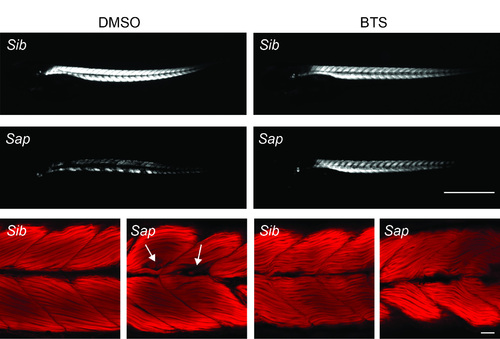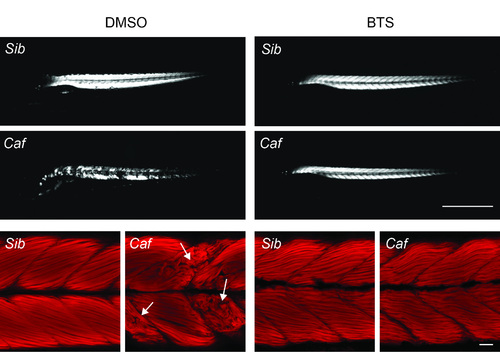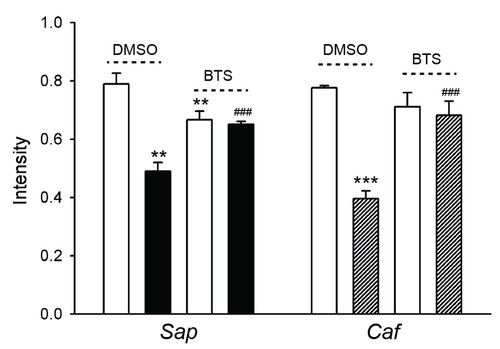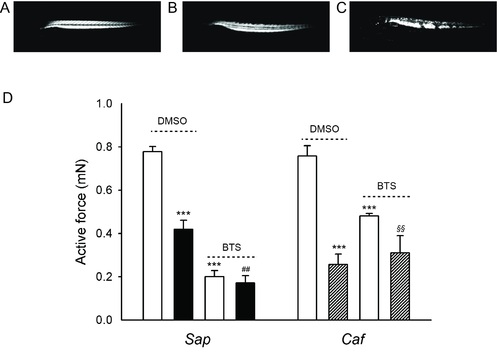- Title
-
Immobilization of Dystrophin and Laminin α2-Chain Deficient Zebrafish Larvae In Vivo Prevents the Development of Muscular Dystrophy
- Authors
- Li, M., Arner, A.
- Source
- Full text @ PLoS One
|
Early immobilization by BTS prevents muscle structural changes in Sapje (Sap) mutant larvae and their normal siblings (Sib) at 4 dpf. Upper panels: birefringence microscopy of Sap and siblings from 0.1% DMSO and 50 µM BTS treatment respectively. Lower panels: whole mount preparations with Rhodamine phalloidin staining. Arrows indicate altered areas. These illustrations were typical of n = 6 Rhodamine phalloidin stained samples per each group, in 3 treatment sets. Scale bars: 1 mm (upper); 50 µm (lower). PHENOTYPE:
|
|
Early immobilization by BTS prevents muscle structural changes in Candyfloss (Caf) mutant larvae and their normal siblings (Sib) at 4 dpf. Upper panels: birefringence microscopy of Caf and siblings from 0.1% DMSO and 50 µM BTS treatment respectively. Lower panels: whole mount preparations with Rhodamine phalloidin staining. Arrows indicate altered areas. These illustrations were typical of n = 6 Rhodamine phalloidin stained samples per each group, in 3 treatment sets. Scale bars: 1 mm (upper); 50 µm (lower). PHENOTYPE:
|
|
Quantification of birefringence intensity in normal siblings (Sib, open bars) and mutated larvae of Sapje (Sap, filled bars) and Candyfloss (Caf, hatched bars), at 4 dpf. Larvae were treated with 0.1% DMSO or 50 µM BTS. n = 3-4 in each group. **, p< 0.01 *** p< 0.001 compared to the Sib in DMSO, ###, p<0.001 compared to the mutants (Caf or Sap) in DMSO (ANOVA, Holm-Sidak method). No significant difference was detected between the BTS treated groups. PHENOTYPE:
|
|
Active force measurements from Sapje (Sap), Candyfloss (Caf) mutant larvae and their siblings (Sib) at 4 dpf. Panel A -C show representative force traces of single twitch contraction from a sibling, Sap and Caf mutant larva respectively. Panel D shows the summarised data from 4 dpf Sap (filled bars), Caf mutant (hatched bars) and Sib larvae (open bars) with, or without BTS immobilization. ***, p<0.001 compared to the Sib in DMSO (ANOVA, Holm-Sidak method). No significant difference was detected between the BTS treated groups. n = 4-10 in Sib groups; n = 3-5 in Sap and Caf groups. PHENOTYPE:
|
|
Recovery in E3 medium after BTS immobilization induces structural changes in Candyfloss (Caf) larvae at 5 dpf. Panel A-C shows birefringence microscopy of a Sibling (Sib), Sapje (Sap) and Caf larva from one-day E3 medium recovery. Panel D summarizes the corresponding force measurements of two mutant strains at 5dpf. Sap: filled bars; Caf: hatched bars; Sib: open bars. ***, p<0.001 compared to the Sib in DMSO, ##, p<0.01 compared to the Sap in DMSO, § §, p<0.01 compared to the Sib in BTS (ANOVA, Holm-Sidak method). No significant difference was detected between the BTS treated Sap groups. n = 3-10 in Sib groups; n = 3 in Sap and Caf groups. PHENOTYPE:
|

Unillustrated author statements PHENOTYPE:
|





